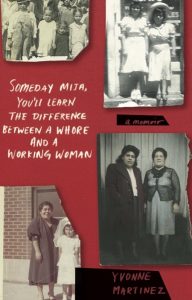Someday Mija, You’ll Learn the Difference Between a Whore and a Working Woman
I HAD TO WRITE IT.
 Putting the words on the page was a commitment to the truth. One line led to the next. Sentence after sentence, a story unfolded. As it took shape, the narrative gathered itself into a bigger story. A story down on a page about a secret or something that nobody wanted to talk about made it real. I felt a charge from my stomach to my heart, an overall warmth, when I had told myself the truth even if nobody else saw it or wanted to see it.
Putting the words on the page was a commitment to the truth. One line led to the next. Sentence after sentence, a story unfolded. As it took shape, the narrative gathered itself into a bigger story. A story down on a page about a secret or something that nobody wanted to talk about made it real. I felt a charge from my stomach to my heart, an overall warmth, when I had told myself the truth even if nobody else saw it or wanted to see it.
In letters to my grandmother as a child, I wrote her about my mother’s erratic behavior and wondered if my mother was crazy. I got a sharp rebuke from my usually loving grandmother. Later I learned, my mother did have undiagnosed bi-polar disorder, but the family acted like nothing was wrong. It hurt to get that rebuke from my grandmother, but when nobody died, I just kept going. I started writing letters and putting them in the envelopes my mother brought home from the envelope factory where she worked. On the way to school or to the store, I’d drop the envelopes on the ground.
I loved watching people pick them up and read them. I don’t remember what I wrote in them. I was just thrilled that someone would bother to pick them up and read them. I was determined to get a story out. Between my anonymous missives to neighborhood strangers and sanitized letters to my grandmother, I continued to write. Furtive and sequestered at first, the truth in the essays in my book “Some Day Mija, You’ll Learn the Difference Between a Whore and a Working Woman” almost chased itself into existence. I worked full time and raised a family, yet every time I had an hour here or there I followed the stories like crumbs in the forest until they led me through to a path.
Along the way, I met the Dangerous Writers Group led by Tom Spanbauer in Portland, Oregon. In Tom’s basement, I apprenticed for many years until I got the journey skills of crafting a story. I learned about going deeper by “going on the body” to describe a story as it felt on the body, my own or a character’s. In one essay, the feel of satin on my grandmother’s lap under my legs as I sat on her lap led me to a story that uncovered a dark event I barely escaped from.
Identifying the “horses” which are themes within a story. Several essays in, I learned that there were a series of sacred objects that were tarnished in some way, symbolizing the messages I received about limits to grace for illegitimate poor brown girls like me. There was an unblessed holy medal I chose to wear, a grade school religious statue of Mary that somebody painted a mustache on, a venerated saint on our car dashboard that never existed and the open mocking of sacred church relics.
Using “burnt tongue” language records the actual way that people speak, as opposed to the detached form of essay writing language taught in most basic English comp classes. For example: It wasn’t “Don’t you touch Mrs. Jenkins roses.” To “Don (pronounced doan) chu touch Mz. Jenkins roses.” These tools and other tools turned the surface text of my explorations, the straw if you will, into gold.
The churning of the essays was not as easy as milling grain. I would often get stuck in places, where the depth of the story was too terrifying for me to enter into; here again, work and family were a welcome distraction. The often-unconscious desire to excavate, to find out what new freedom lie in an unearthed truth would usually overtake the fear. That’s why it took years to write the stories, one essay at a time.
When I left Portland, Oregon, where I apprenticed with Tom and a whole coterie of his writers-in-training, it was even harder, because I didn’t have my erstwhile writerly knave companions to grind with. Relying on the “polished” essays I had already collected. I found coffee shops in Portland, Oregon, Santa Monica, Venice Beach, Salinas, San Francisco, Berkeley to write in. I built my whole work week around those precious hours to hour and one half.
When I got fired or laid off (for organizing or pissing off some boss) and had all the time I wanted to write, I couldn’t command a sentence. There was something about getting away with it (writing) that I thought I needed.
When my sister, my youngest sibling, died at an early age ten years ago, I gathered what I had and got serious about submitting them to publications and trying to find a publisher. My sister, herself, was starting to write. My book is dedicated to her memory. After lots of efforts, I found an indie hybrid publisher at She Writes Press and an amazing editor. Annie Tucker shepherded my collection of essays into a book.
What I most appreciate about She Writes Press is the comprehensive support it provides, and the in-depth nuts and bolts insight into the publishing industry. A pulling away of the curtain, if you will, to expose the wizard behind the curtain; a wholesale demystification of the book industry. In that truth, there is hope for writers who want to get their stories out.
As I built a foundation of stories, like building a house, I began to build a frame on top of it. I built the sides first, attached them and then finally pulled the sides together by framing the roof. I didn’t know how many rooms I would need, but just let myself move from one to the next until I could see story threads looped back and forth to provide texture and strength. As I moved through the narratives the stories just propelled themselves forward, until, I could find the through line.
It’s never really over, but I am at least done with this part of it. Like an ongoing path of discovery, it begs yet new questions. It summons new paths, new inquiries. The outcomes so far have been beyond my wildest imagination, a five-star review, the beginning of a me-too movement in the labor movement. At the very least, a testimony from an activist who suffered discrimination as I have within a progressive movement.
Who knows where we go from here?
One question has pushed through: Where is the body of Cirilo Rico? He was our first patriarch and was killed as a bandit by the Mormons in Utah in 1922 one hundred years ago almost to the day that my book will be published. Why was my great grandmother put in jail with her children for “harboring” him? Even though there is front page coverage of the story, including a quote from my great-grandfather, the state of Utah has no official record of his death.
—
BIO: Yvonne Martinez is a retired labor negotiator/organizer. She has been published by ZyZZyVa, Crab Orchard Review, Labor Notes, and NPR. She also formerly wrote a local labor blog in the San Francisco Bay Area. Her forthcoming memoir in essays, Someday Mija, You’ll Learn the Difference Between a Whore and a Working Woman, covers her childhood in Salt Lake City/South Central/Boyle Heights and her work as a labor negotiator/organizer in California and the Pacific Northwest. Her play Scabmuggers is based on her experience as a National Fellow of the Harvard Trade Union Program in 1994. Yvonne lives in Berkeley, CA, and Portland, OR.
Someday Mija, You’ll Learn the Difference Between a Whore and a Working Woman
 “Someday Mija, You’ll Learn the Difference Between a Whore and a Working Woman is a memoir that turns time on its head, circling through terror and joy with eloquence and becoming its own sacrament of resistance.” —Foreword Reviews, 5-star review
“Someday Mija, You’ll Learn the Difference Between a Whore and a Working Woman is a memoir that turns time on its head, circling through terror and joy with eloquence and becoming its own sacrament of resistance.” —Foreword Reviews, 5-star review
At eighteen, Yvonne Martinez flees brutal domestic violence and is taken in by her dying grandmother . . . who used to be a sex worker. Before she dies, her grandmother reveals family secrets and shares her uncommon wisdom. “Someday, Mija,” she tells Yvonne, “you’ll learn the difference between a whore and a working woman.” She also shares disturbing facts about their family’s history—eventually leading Yvonne to discover that her grandmother was trafficked as a child in Depression-era Utah by her own mother, Yvonne’s great-grandmother, and that she was blamed for her own rape.
In the years that follow her grandmother’s passing, Yvonne gets an education and starts a family. As she heals from her own abuse by her mother and stepfather, she becomes an advocate/labor activist. Grounded in her grandmother’s dictum not to whore herself out, she learns to fight for herself and teaches others to do the same—exposing sexual harassment in the labor unions where she works and fighting corruption. Intense but ultimately uplifting, Someday Mija, You’ll Learn the Difference Between a Whore and a Working Woman is a compelling memoir in essays of transforming transgenerational trauma into resilience and post-traumatic growth.
BUY HERE
Category: On Writing

























